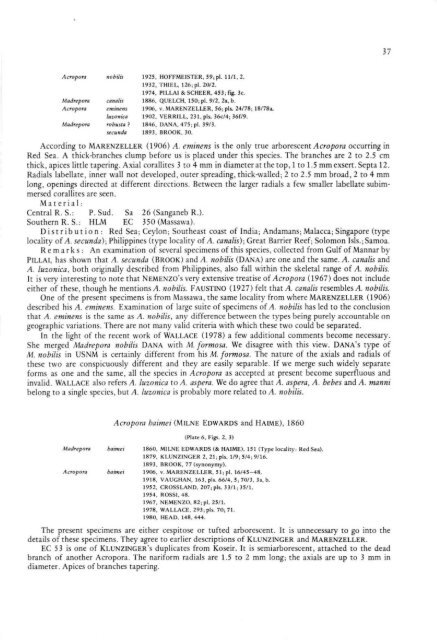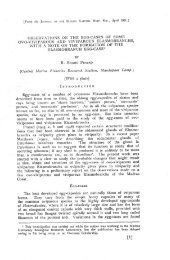PDF - Eprints@CMFRI
PDF - Eprints@CMFRI
PDF - Eprints@CMFRI
You also want an ePaper? Increase the reach of your titles
YUMPU automatically turns print PDFs into web optimized ePapers that Google loves.
37<br />
Acropora<br />
Madrepom<br />
Acropora<br />
Madreportl<br />
nobUis 1925, HOFFMEISTER, 59; pI. 1111.2.<br />
1932. THIEL, 126 ; pI. 20/ 2.<br />
1974. PILLAI & SCHEER. 453 ; fig. 3e.<br />
canalis 1886. QUELCH, ISO: pI. 9/ 2. 2a. b.<br />
eminens 1906 . .... MARENZELLER. 56; pis. 24178 ; 1a17Sa.<br />
/u:onica 1902. VER RI LL. 231, pis. 36c/ 4 ; 36f19.<br />
robusta? 184-6, DANA. 475; pI. 39/ 3.<br />
secunda 1893, BROOK , 30.<br />
According to MARENZELLER (1906) A. eminens is the only true arborescent Acropora occurring in<br />
Red Sea. A thick-branches clump before us is placed under this species. The branches are 2 to 2.5 em<br />
thick, apices little tapering. Axial corallites 3 to 4 mm in diameter at the top, 1 to 1.5 mm exsert. Septa 12.<br />
Radials labellate, inner wall not developed, outer spreading, thick-walled; 2 to 2.5 mm broad, 2 to 4 mm<br />
long, openings directed at different directions. Between the larger radials a few smaller labellate subimmersed<br />
corallites are seen.<br />
Material :<br />
Central R. S.: P. Sud . Sa 26 (Sanganeb R .).<br />
Southern R . S. : HLM EC 350 (Massawa).<br />
Dis t rib uti 0 n : Red Sea; Ceylon ; Southeast coast of India; Andamans; Malacca ; Singapore (type<br />
locality o f A. secunda); Philippines (type loca lity of A. canalis) ; Great Barrier Reef; Solomon Isis.; Samoa.<br />
Rem ark s : An examination of several specimens of this species, collected from Gulf of Mannar by<br />
PILLAI, has shown that A. secunda (BROOK ) and A. 1lobilis (DANA) are one and the same. A. canalis and<br />
A. luzonica, both originally described from Philippines, also fall within the skeletal range of A. nobilis.<br />
It is very interesting to note that NEMENZO's very extensive treatise of Acropora (1967) does not include<br />
either of these, though he mentions A. 1lobilis. FAUSTINO (1927) felt that A. canalis resembles A. 1lobilis.<br />
One of the present specimens is from Massawa, the same locality from where MARENZELLER ( 1906)<br />
described his A. emine1ls. Examination of large suite of specimens of A. nobilis has led to the conclusion<br />
that A. eminens is the same as A. nobilis, any difference between the types being purely accountable on<br />
geographic variations. There are not many valid criteria with which these two could be separated.<br />
In the light of the recent work of WALLACE (I978) a few additional comments become necessary.<br />
She merged Madrepora nobilis DANA with M. formosa . We disagree with this view. DANA'S type of<br />
M. nobilis in USNM is certainly different from his M. formosa. The nature of the axials and radials of<br />
these two are conspicuously different and they are easily separable. If we merge such widely separate<br />
forms as one and the same, all the species in Acropora as accepted at present become superfluous and<br />
invalid . WALLACE also refers A. luzonica to A. aspera. We do agree that A. aspera, A. bebes and A. manni<br />
belong to a single species, but A. luz07lica is probably more related to A. nobilis.<br />
Madrepo ra<br />
Acropora<br />
Acropora baime; (MILNE EDWARDS and HAIME), 1860<br />
baime;<br />
ba;",ei<br />
(Plate 6, Figs. 2, 3)<br />
1860, MILNE EDWARDS (& HAIME). IS I (Type local ity : Red Sca).<br />
1879. KLUNZINGER 2, 21 ; pis. 1/9; 5/4: 9/ 16.<br />
1893 , BROOK. 77 (synonymy).<br />
1906, v. ~iARENZELLER , 51 ; pI. 16/45 - 48.<br />
1918. VAUGHAN, 163, pis. 66/4, 5 j 7013 , 3a , h.<br />
1952, CROSSLAND, 207 j pls. H / 1; lSl 1.<br />
1954 . ROSSI . 48.<br />
1967, NEMENZO, 82; pI. 25/ 1.<br />
1978, WALLACE , 293; pis. 70; 71.<br />
1980, HEAD. 148 . 444.<br />
The present specimens are either cespitose or tufted arborescent. It is unnecessary to go into the<br />
details of these specimens. They agree to earlier descriptions of KLUNZINGER and MARENZELLER.<br />
EC 53 is one of KLUNZ INGER's duplicates from Koseir. It is semiarborescenr, attached to the dead<br />
branch of another Acropora. T he nariform radials are 1.5 to 2 mm long; the axials are up to 3 mm in<br />
diameter. Apices of branches tapering.
















